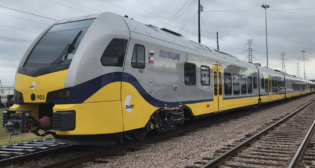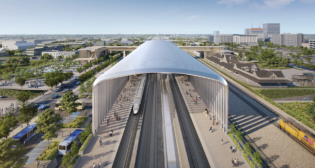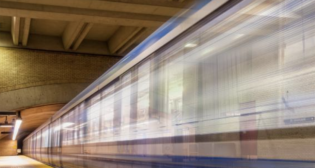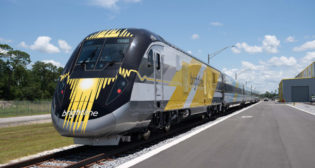
West of Worcester Under Way
Written by David Peter Alan, Contributing Editor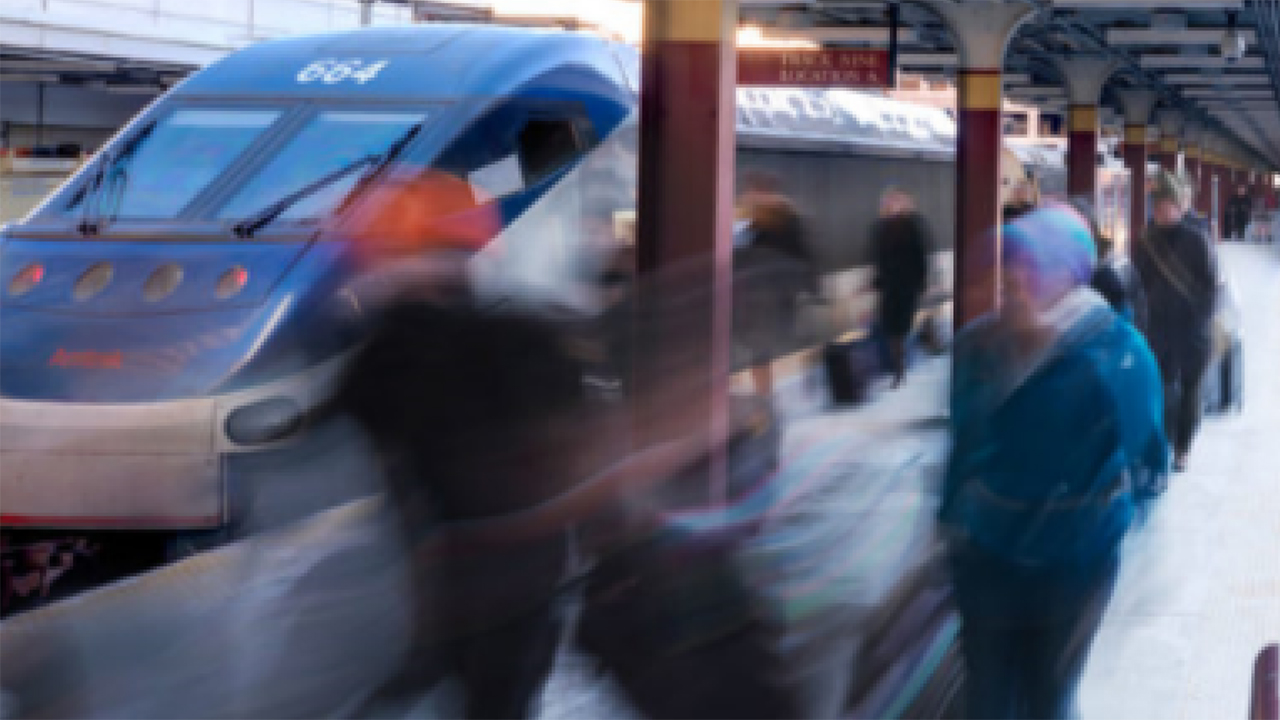
At one time there were many passenger trains on New York Central’s Boston & Albany line that sped across the Bay State, between its namesake cities. There were even a few on the more-northerly route operated by the Boston & Maine through Fitchburg and Greenfield until the Minute Man between Boston and Troy was discontinued in 1957.
Today there is only one train west of Worcester: the Massachusetts section of Amtrak’s Lakeshore Limited, and even that train was discontinued for a few years in the 1970s. But restoration of service, possibly on both routes, is coming closer to reality as a new state-based commission is looking toward bringing more east-west passenger trains to the state.
One member of that commission is Paul A. Lundberg, who has been involved with business ventures in several industries, including a railroad career at the Chicago & North Western (C&NW) and as General Manager of the Massachusetts Bay Commuter Railroad (regional Northside and Southside trains on the MBTA or “the T”), among other places on both the freight and passenger sides. Lundberg told Railway Age, “Things are happening” and officials are making “plans you can actually execute.”
There are three alternatives for service west of Worcester, where the current regional service on the T ends. They involve a range of possibilities and expenditures ranging from slight upgrades to building some dedicated track and running at 110 mph on part of the route. A 2016 study offered six alternatives, two of which proposed service only as far as Springfield. The next study was released in January 2021.
Western Massachusetts Passenger Rail Commission
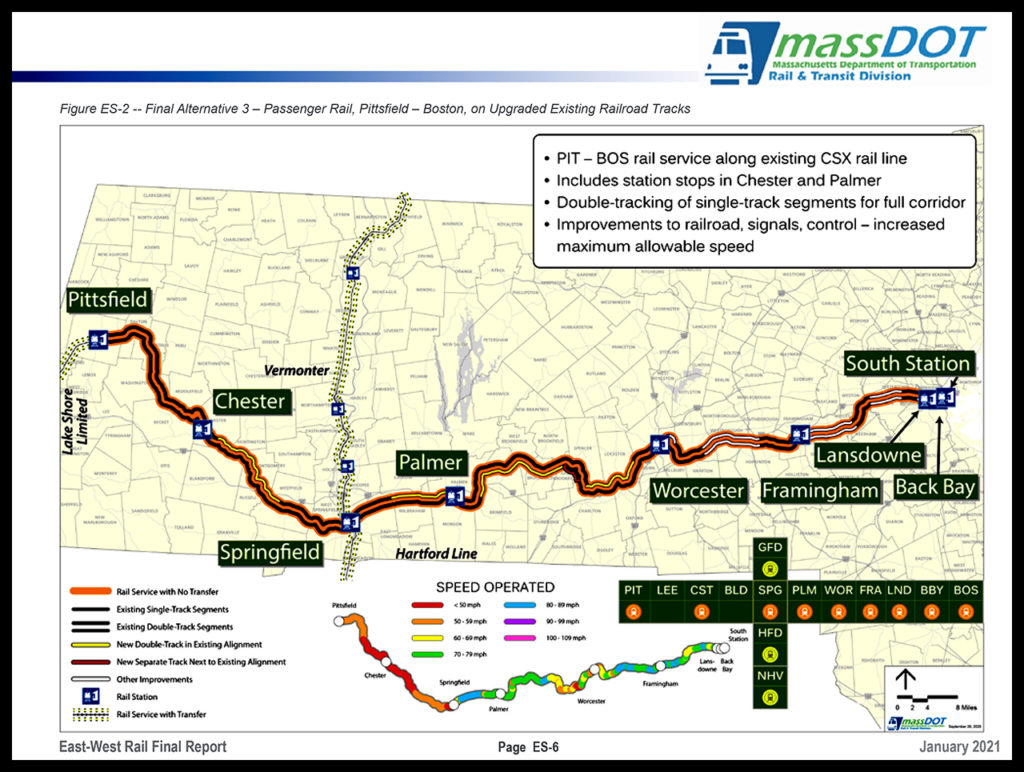
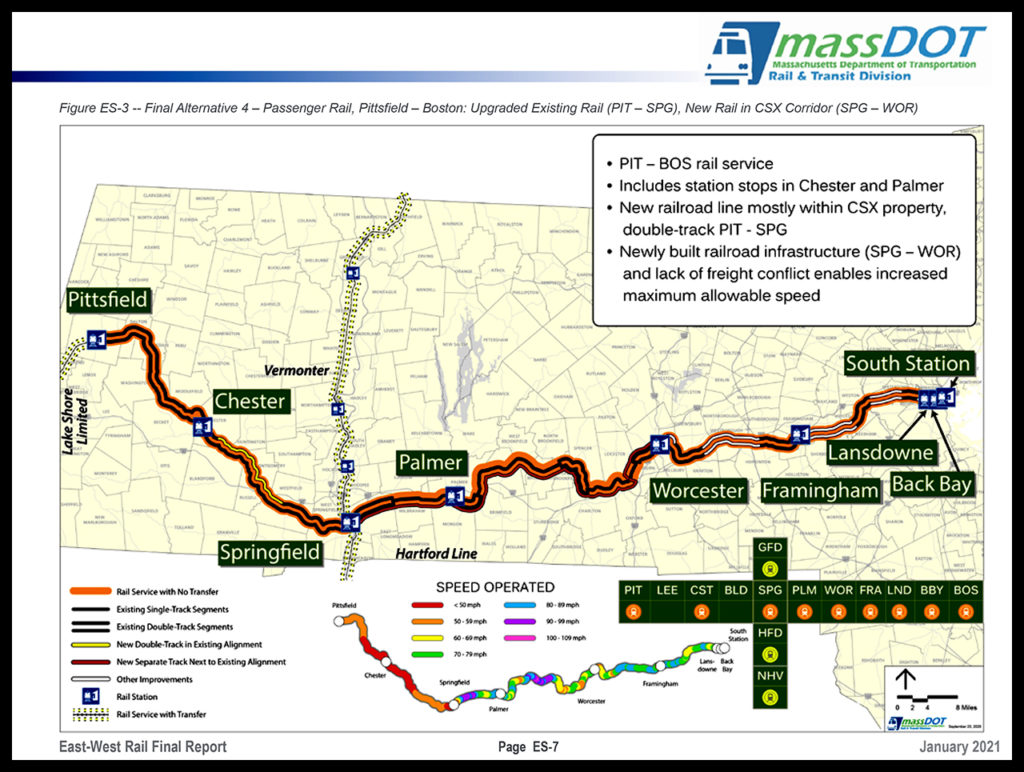
The Massachusetts Department of Transportation (MassDOT) owns the track east of Worcester; CSX still owns it west of there. While MassDOT is represented on the new Western Massachusetts Passenger Rail Commission, it is a separate entity with new legal authority (under §60 of Ch. 176 of Mass. Gen. Laws, 2022). Lundberg characterized it as “equivalent to the ‘T’ for the rest of the state.” The commission was established by the legislature last year, and its Co-Chairs are Transportation Chairs Rep. William Straus and Sen. Brendan Crighton. Most of the members are elected officials or business leaders, with Lundberg contributing experience in railroad management. The Commission has no members who would represent riders.
A comprehensive overview of the Commission and its enabling legislation can be found on the website of Trains In the Valley, an organization that advocates for passenger rail in the Pioneer Valley (the region near Springfield) and elsewhere in New England. That organization has supported the proposed expansion of east-west service strongly and urged residents of the area to voice their support at the Commission’s hearings. The site also contains an equally comprehensive overview of “future service” for east-west passenger rail in Massachusetts, including the history of the initiative.
The most recent report, the “Final Report” from a MassDOT study released in January 2021 (download below), called for three alternatives, which would add between seven and nine new daily round trips, and additional stops at Palmer (east of Springfield) and Chester (between Springfield and Pittsfield). An earlier report. the 2016 Northern New England Intercity Rail Initiative (NNEIRI) Study included six alternatives, two running only as far as Springfield, either through-running from Boston or as a shuttle from Worcester. According to Trains in the Valley, “In 2016 MassDOT chose not to move forward with any of the recommendations from the NNEIRI study for reasons that were never fully explained.”
The 2021 study and ongoing efforts are focusing on Pittsfield as the western destination, with a corridor-level frequency of service. There is also a push for including a stop at Palmer, west of Worcester and closer to Springfield. According to Lundberg, local advocates say it would be a useful stop to serve the colleges and universities in the area. There are only two daily round trips by bus between Springfield and Palmer today, with the morning bus from Springfield (at 8:50) leaving before any trains from New York, New Haven, and Hartford arrive, and making a questionable (ten-minute) connection with the 5:15 a.m. bus from New York.
Possible Northern Route
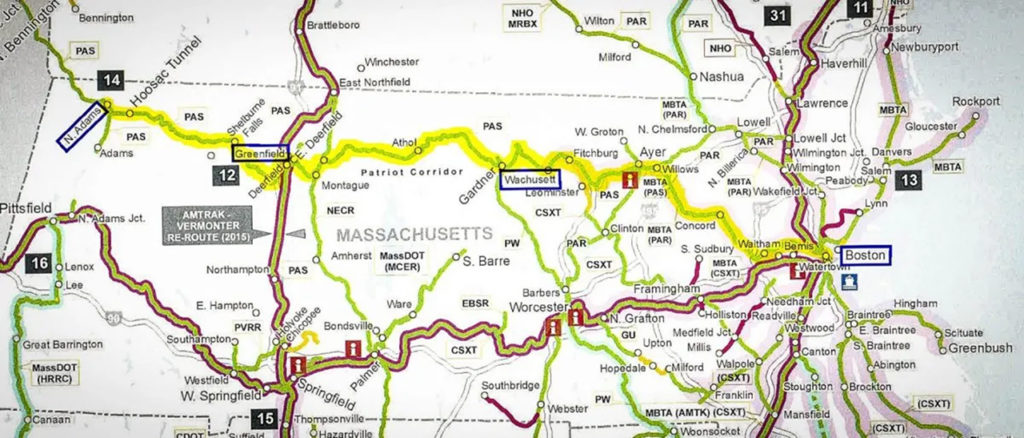
There is another study under way about restoring service on the state’s Northern Tier. The proposed service would extend west of Fitchburg (where current T service ends), through Gardner (which had service from 1980 until 1986) and Greenfield to North Adams (where service ended in 1958) and Williamstown, the home of Williams College. That service would connect at Greenfield with Amtrak’s Vermonter and the new Valley Flyer trains that were recently extended from Springfield to serve Holyoke, Northampton and Greenfield. According to Lundberg, legislators from the northwestern corner of the state have been pushing for the return of the northern route.
The official website for the Northern Tier Passenger Rail Study contains documents about the study, including a series of newsletters issued by MassDOT, the most-recent dated April 29. The study was initiated by the Legislature in 2019. As with the other east-west study, the “working group” consists of elected officials, rail managers and business leaders, but no rider representatives. There is a comprehensive overview of the study and possible future service on the Trains in the Valley website.
Expanding South Station?
Plans call for expansion at South Station to accommodate three new services under construction, or at least under consideration. The first is the proposed corridor to Pittsfield, which might be coupled with increased Amtrak service to Albany-Rensselaer. The second would be restoration of the Inland Route (also known as the Springfield Line) between Boston and New York, through Springfield, Hartford and New Haven. Amtrak ran limited service on that route at various times in the past, but usually limited to one daily train in each direction. The route takes longer than the Shore Line, which is part of Amtrak’s Northeast Corridor (NEC), but it would allow direct service between Boston, Worcester, Springfield, Hartford, New Haven and New York on a limited number of trains. The third is the South Coast Rail project that would restore service to New Bedford and Fall River for the first time since 1958. That project is expected to be completed next year, so it is anticipated that trains will run soon.
Lundberg gave a presentation on May 16, “Current South Station Expansion and Planning,” where he gave details of the construction that is planned for South Station and its immediate area to expand the station, from its current 13 tracks served by 8 platforms to add 7 more tracks to be served by 4 new platforms; a 54% increase in the number of station tracks. He said that South Station should be expanded for operational reasons, to accommodate those three new services.
But is South Station expansion necessary? While there is construction ongoing around South Station, it is unclear whether such expansion will actually be needed for the service that can reasonably be expected. A 2017 Environmental Impact Statement (EIS) that Lundberg cited said South Station will become crowded, addingf that the study at issue did not contemplate east-west service, the Springfield Line or South Coast Rail. In his May 16 presentation, he claimed that daily ridership (presumably that means on weekdays) would rise 41% by 2035 (from 46,000 to 65,000), and that daily trains would increase from 450 to 550; a 22% increase.
Looking at current forecasts, the T is projecting 26 trains each way for South Coast Rail service: “three morning peak-hour trains and three evening peak-hour trains to both New Bedford and Fall River” and three trains during “off-peak” hours, which only adds up to 12 if the trains split into separate sections along the route. Adding the nine trains in each direction projected for west of Worcester, that makes 18 more. Then there would be three trains each way on the Inland Route to New York, adding six. That adds up to 50 trains arriving to/from South Station, maybe as few as 36 if the South Coast trains split and join at a junction along the route.
What would account for the other 60 or more trains in and out? Lundberg said they could include non-revenue trains. In theory, others might constitute expanded service on the existing lines, but it appears unlikely that adding trains outside traditional peak commuting times would impose or exacerbate a capacity constraint that would necessitate a 54% capacity increase and its associated capital cost. It should be noted, however, that the cited numbers came from the 2017 Environmental Assessment (Section 4(f)). Lundberg said, “The Commission Report should recommend that the new Authority review and revise if necessary.”
There has been a counter-factor operating in recent years, especially at South Station. Since the COVID-19 virus struck in 2020, five-day commuting has been on the decline everywhere, and it is unclear how much it will recover in the future. Current schedules on the T reflect that change, as the operational “commuting peak” has essentially disappeared from the Boston rail scene. Trains on most lines now run hourly throughout the day on weekdays. That represents a cut from a busy morning peak and sparse service during mid-day, perhaps as infrequently as every two hours or less. With a more-balanced schedule throughout the service day, there is less pressure on South Station’s capacity at what used to be its busiest times, which could mean room for the new services without the need for large-scale spending to add infrastructure to make room for those trains. We will learn more a month from now
Despite Lundberg’s optimism, there might be a political problem, as a May 9 post on the website of Citizens for a Palmer Rail Stop warned: “In April the Massachusetts House of Representatives eliminated Gov. Healey’s proposed $12.5 million for East-West rail from its budget. Instead the House Budget includes the following: $100 million for MBTA bridge work; $100 million for MBTA station improvements; $39 million for MBTA subway track and signal work; $11 million for design of the Red-Blue connector.” The latter project refers to a direct connection between the Red and Blue Lines on the local rail system in Boston, the only two lines that lack such a connection.
Lundberg remains undeterred. He concluded his interview by saying: “In the railroad business, you always look for the stars to be in alignment.” He added that they seem to be aligned now, “if people keep up the public interest noise. The legislature created an operating authority that would be the boss of all this and has the authority to make an operating plan borrow money, receive federal funds, buy insurance and do other things that a commission is supposed to do,” even if some numbers are subject to revision.
Concerning the east-west project, Lundberg concluded, “There should be the momentum to push this over the top.” There have been six public meetings concerning the project, and the Western Massachusetts Passenger Rail Commission is due to issue a report on June 30. We will learn then how much “momentum” has resulted in a desire by legislators and other officials to re-establish passenger trains in Western Massachusetts. We will report to you when we know the results.
